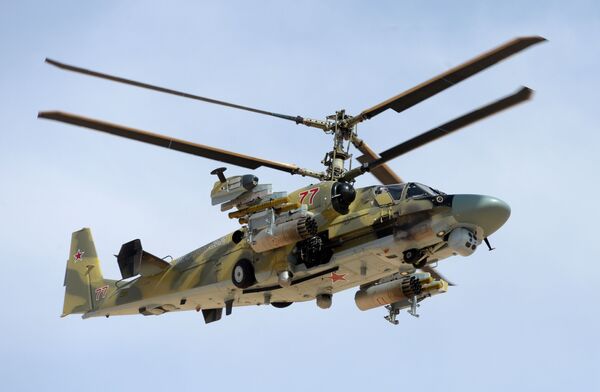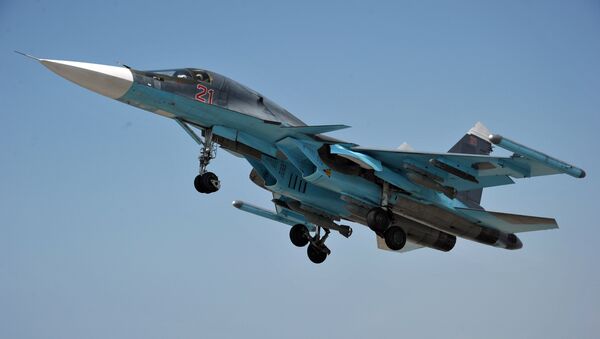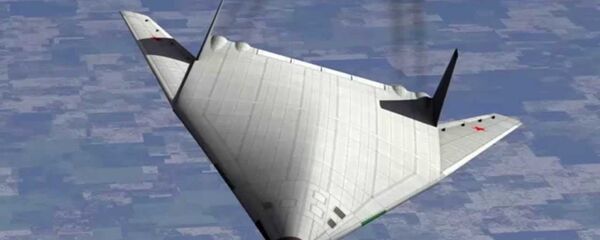"We will receive no fewer [planes and helicopters] in 2018 than we got this year. More than a hundred new vehicles plus modernization and overhaul of those that are currently in service. Everyone knows perfectly well that the world today is moving along the path of development of the aerospace component which includes new technologies and developments," Bondarev said.
He added that "at the end of the day, all this will affect the development of [the country's] national economy and industry."
Tactical Level
Right now, the Russian Aerospace Forces include about 3,800 different types of aircraft, as well as around 1,400 multipurpose, strike and transport helicopters.
"One can safely say that Russia's fleet of operational and tactical aviation will be upgraded in line with the planned threshold of 80-90 percent," Russian military expert Viktor Murakhovsky told Sputnik, citing the Su-30SM and the Su-35S fighter jets, as well as the new MiG-35 fighters and the Su-34 frontline bombers.
"The fifth generation T-50 PAK FA fighter jet is expected to be put in serial production before 2020. Positive dynamics are in place in the army aviation, which receives dozens of the new Mi-28N, the Mi-35 and the Ka-52 combat helicopters, as well as modern modifications of the Mi-8 helicopter," Murakhovsky said.
In 2018, the Russian Aerospace Forces are due to receive about 30 Su-30SM multipurpose fighters, around 20 super-maneuverable Su-35S fighter jets and 16 Su-34 frontline fighter-bombers.

All these aircraft have confirmed their advanced characteristics in combat conditions of the Syrian air campaign, which is why experts are upbeat about these warplanes being part of the Russian Aerospace Forces, according to Murakhovsky.
Strategic Level
Russia's long-range and strategic aviation will not receive principally new planes in 2018.
The Tu-22M3M will be able to carry air-to-surface X-32 cruise missiles, a deep upgrade of the older X-22 missiles. The bomber is equipped with a more powerful engine and a noise-proof radar-inertial guidance system.
The X-32 missile could hit a target at a distance of up to 1,000 kilometers, which would allow the Tu-22M3M to launch it without entering an enemy's air defense zone.
The Tupolev Tu-160 is a supersonic, variable-sweep wing heavy strategic bomber designed by the Soviet Union pic.twitter.com/CC6eZAqYg7
— History of Warplanes (@warplanefeed) 23 июля 2017 г.
The Russian strategic bomber Tu-160 is also being modernized, with the first prototype of the Tu-160M2 due to appear in 2019. It was reported that the new aircraft will be the basis of the air component of the Russian "nuclear triad" and will remain its part until 2030.
In an interview with Radio Sputnik, the deputy editor-in-chief of Aviapanorama journal and a former air force pilot, Vladimir Popov, said that the Tu-160M2 will essentially be a new plane.
Worlds Fastest Bomber Aircraft!!! Tu-160 Aircraft https://t.co/97p9jV1Wod #usmilitary
— Military Stuff (@milstuf) 24 июля 2017 г.
"Even though on the outside it looks much like its predecessor, the Tu-160MS2 will be a whole new aircraft with a new fire control and navigation gear, an advance system of electronic jamming, a new cockpit and more fuel-saving engines. Everything possible is being done to extend its supersonic ability. This is the bottom line of the current overhaul," Popov said.
The Tu-160MS2 will be powered by upgraded engines with better endurance characteristics, which adds to the new bomber's range, increasing it by 1,000 kilometers (621miles) as compared with the existing version.
A Brand-New "Night Hunter"
According to Viktor Bondarev, in 2018, an upgraded version of the Mi-28NM "Night Hunter" attack helicopter will be put into service at the Russian Aerospace Forces.
Additionally, the helicopter will be equipped with new blades, a motor with increased characteristics, electronic warfare systems and, most importantly, a H025 radar station capable of providing circular detection of targets.
In addition, the radar will assume the function of guiding the missiles equipped with a radio command system. Previously, this task was performed by the specific green "nose" of the Mi-28N, which in the new modification will be significantly shorter.
In the Stavropol Territory, the crews of the Mi-8AMTSh, Mi-28N and Mi-35M #helicopters carry out live firing#Russia #RuAF pic.twitter.com/Dk1uZgZfLQ
— Russian Air Force (@Ruaf_Hmeimim) 12 июля 2017 г.
Last week, Deputy Defense Minister Yury Borisov said that the Russian Defense Ministry is planning to buy around 15 medium multipurpose Mi-38 helicopters.
"We are, without doubt, interested in this machine. A purchase of around 15 Mi-38 helicopters is envisaged," Borisov told reporters at the MAKS 2017 air show.

Made of composite materials, the Mi-38 can carry both cargo and passengers, and can be used in search-and-rescue missions and as a flying hospital, as well as for offshore operations.
According to Murakhovsky, in terms of the production of operational-tactical and army planes, Russia managed to resolve the issue of import substitution almost completely."
"Five years ago, we seriously depended on helicopter engines produced by the Ukrainian concern, Motor Sich. However, the United Engine Corporation managed to fully organize its own production in Russia within a three-year period. The same can be said about the production of engines for many cruise missiles," he said.







